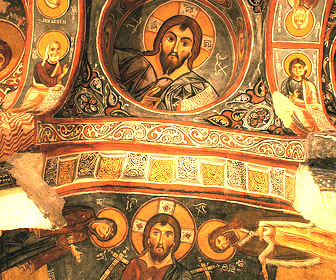 |
 |
| |
|
| |
Churches of Goreme | Elmali Church, Church of Barbara, Dark Church

|
| |
The soft rocks formed from the lava of a volcanic eruption 2000
years ago have made it possible for the people of Goreme, in the
region of Cappadocia, to carve out homes, churches and monasteries
in the rock faces. The cave churches in this area contain many
examples of Byzantine art from the post iconoclastic period and are
a unique artistic achievement from this age.
The restoration of the Church of the Buckle (Tokalı Kilise) was
finished in the 1980’s. It is the biggest church in Göreme and
contains frescoes in the provincial style. There are 11th century
frescoes in the metropolitan style and representations of the twelve
apostles, the saints and stories from the life of Jesus. The Church
of the Buckle is made up of four chambers and has a crypt located
underneath the nave. |

|
|
| |
|
|
| |
The Apple Church (Elmalı Kilise) was built in about 1050 AD and the
name is said to refer to a picture on the dome which shows the
Archangel Michael holding a red colored orb. The four pillars that
support the church’s central dome bear the sign of the Greek cross.
Although restoration has been completed, the paint still continues
to fall away and this has revealed some interesting earlier frescoes
underneath.
The Egyptian Saint Barbara was tortured and killed by her father for
practicing Christianity. The Church of Saint Barbara (Barbara Kilise)
is dedicated to her and contains frescoes depicting Christ on a
throne and geometric patterns painted in red ochre. A painting of a
locust being warded away by two crosses is said to represent evil.
Saint George and Saint Theodore are also featured in the frescoes;
the two of them on horseback fighting against a dragon and a snake.
The Church of Saint Barbara has the impression that it was built
using cut stone because of the red ochre lines that the monks drew
on the walls.
Although it was used to house pigeons until the 1950’s, the Dark Church (Karanlık Kilise) houses the best preserved examples of 11th
century Byzantine art in the whole of Cappadocia and can be visited
for an extra fee.
The Church with Sandals (Çarıklı Kilise) has a cross floor plan and
takes it name from footprints found at the bottom of a frescoe
depicting the ascension of Christ at the entrance to the church. The
footprints are the source for many myths and legends.
The open air museum where these churches can be found is located a
couple of kilometers away from the village of Göreme on the road to
Ürgüp and can be reached easily by foot.
The village of Göreme is
also well worth a visit as some of the locals still inhabit and work
in the cave dwellings. It is possible to stay in Göreme in hotels
carved out of the rocks but of course at a premium price.
|
|
| |
|
|
| |
|
|
| |
|
|
| |
|
<-Back
|
|
|
 |
|
